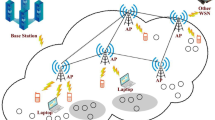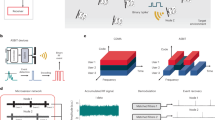Abstract
Motivated by the energy-efficient computation of the brain, an energy-efficient wireless sensor network infrastructure is built for solving the pattern recognition task. In this work, spatiotemporal patterns originate from the wireless sensor nodes that use pulse-based networking schemes like pulse position-coded packet data unit and spiked time-division multiple access. Pulse-based networking schemes use spatiotemporal patterns to encode information rather than using traditional energy-expensive packets. These spatiotemporal patterns are learned through biologically plausible learning rule of Tempotron which is a neuronal binary classifier that uses a gradient-descent supervised learning rule to adjust the weights of synaptic inputs. A single Tempotron-trained spiking neuron is shown to read out information encoded in the spike timings of synaptic inputs. However, due to the simplicity of the single Tempotron classifier, its performance is inherently limited. In this work, we devise the multilayer spiking neuron training rules for event pattern classification in distributed wireless sensor networks. We also show that the proposed architecture improves classification accuracy by a considerable amount as compared to a single Tempotron model’s performance.














Similar content being viewed by others
References
Zellers, R., Bisk, Y., Farhadi, A., & Choi, Y. (2019). From recognition to cognition: Visual commonsense reasoning. In Proceedings of the IEEE conference on computer vision and pattern recognition (pp. 6720–6731).
Rai, R., & Rai, P. (2019). Survey on energy-efficient routing protocols in wireless sensor networks using game theory. In Advances in communication, cloud, and big data. Springer (pp. 1–9).
Yang, T.-J., Chen, Y.-H., Emer, J., & Sze, V. (2017). A method to estimate the energy consumption of deep neural networks. In 51st Asilomar conference on signals, systems, and computers. IEEE, 2017 (pp. 1916–1920).
Zambrano, D., Nusselder, R., Scholte, H. S., & Bohte, S. (2017). Efficient computation in adaptive artificial spiking neural networks. arXiv preprint arXiv:1710.04838.
Wang, W., Subagdja, B., Tan, A.-H., & Starzyk, J. A. (2012). Neural modeling of episodic memory: Encoding, retrieval, and forgetting. IEEE Transactions on Neural Networks and Learning Systems, 23(10), 1574–1586.
Xin, J., & Embrechts, M. J. (2001). Supervised learning with spiking neural networks. In IJCNN’01. International joint conference on neural networks. Proceedings (Cat. No. 01CH37222), vol. 3. IEEE (pp. 1772–1777).
Kasabov, N. K. (2014). Neucube: A spiking neural network architecture for mapping, learning and understanding of spatio-temporal brain data. Neural Networks, 52, 62–76.
Merolla, P. A., Arthur, J. V., Alvarez-Icaza, R., Cassidy, A. S., Sawada, J., Akopyan, F., et al. (2014). A million spiking-neuron integrated circuit with a scalable communication network and interface. Science, 345(6197), 668–673.
Wang, X., Lin, X., & Dang, X. (2020). Supervised learning in spiking neural networks: A review of algorithms and evaluations. Neural Networks.
Gütig, R., & Sompolinsky, H. (2014). Tempotron learning. In Encyclopedia of computational neuroscience. Springer.
Feng, D., Das, S., Hajiaghajani, F., Shi, Y., & Biswas, S. (2019). Pulse position coded medium access in energy-starved networks. Computer Communications, 148, 62–73.
Feng, D., Shi, Y., Das, S., & Biswas, S. (2019). Energy-efficient and secure data networking using chaotic pulse position coded PDUS. IEEE Transactions on Green Communications and Networking, 4(2), 375–386.
Das, S., & Biswas S. (2018) A scalable pulse protocol for structural health monitoring. In 2018 10th international conference on communication systems and networks (COMSNETS). IEEE (pp. 206–213).
Tavanaei, A., Ghodrati, M., Kheradpisheh, S. R., Masquelier, T., & Maida, A. (2019). Deep learning in spiking neural networks. Neural Networks, 111, 47–63.
Deng, L. (2012). The mnist database of handwritten digit images for machine learning research [best of the web]. IEEE Signal Processing Magazine, 29(6), 141–142.
Bohte, S. M., Kok, J. N., & La Poutré, J. A. (2000). Spikeprop: Backpropagation for networks of spiking neurons. ESANN, 48, 17–37.
Florian, R.V. (2008). Tempotron-like learning with resume. In International conference on artificial neural networks. Springer (pp. 368–375).
Mohemmed, A., Schliebs, S., Matsuda, S., & Kasabov, N. (2012). Span: Spike pattern association neuron for learning spatio-temporal spike patterns. International Journal of Neural Systems, 22(04), 1250012.
Banerjee, A. (2016). Learning precise spike train-to-spike train transformations in multilayer feedforward neuronal networks. Neural Computation, 28(5), 826–848.
Zenke, F., & Ganguli, S. (2018). Superspike: Supervised learning in multilayer spiking neural networks. Neural Computation, 30(6), 1514–1541.
Yu, Q., Tang, H., Hu, J., & Tan, K. C. (2017). Temporal learning in multilayer spiking neural networks through construction of causal connections. Neuromorphic Cognitive Systems (pp. 115–129). Springer.
Wu, Y., Deng, L., Li, G., Zhu, J., & Shi, L. (2018). Spatio-temporal backpropagation for training high-performance spiking neural networks. Frontiers in Neuroscience, 12, 331.
Gehrig, D., Loquercio, A., Derpanis, K. G., & Scaramuzza, D. (2019). End-to-end learning of representations for asynchronous event-based data. In Proceedings of the IEEE international conference on computer vision (pp. 5633–5643).
Victor, J. D., & Purpura, K. P. (2010). Spike metrics. In Analysis of parallel spike trains (pp. 129–156). Springer.
Kasabov, N., & Capecci, E. (2015). Spiking neural network methodology for modelling, classification and understanding of eeg spatio-temporal data measuring cognitive processes. Information Sciences, 294, 565–575.
Gewaltig, M.-O., & Diesmann, M. (2007). Nest (neural simulation tool). Scholarpedia, 2(4), 1430.
Author information
Authors and Affiliations
Corresponding author
Additional information
Publisher's Note
Springer Nature remains neutral with regard to jurisdictional claims in published maps and institutional affiliations.
Rights and permissions
About this article
Cite this article
Kasi, S.K., Das, S. & Biswas, S. Energy-efficient event pattern recognition in wireless sensor networks using multilayer spiking neural networks. Wireless Netw 27, 2039–2054 (2021). https://doi.org/10.1007/s11276-021-02555-9
Accepted:
Published:
Issue Date:
DOI: https://doi.org/10.1007/s11276-021-02555-9




